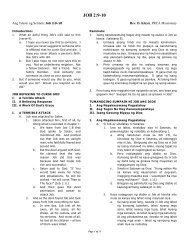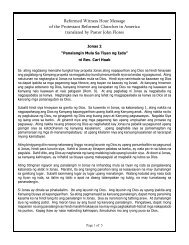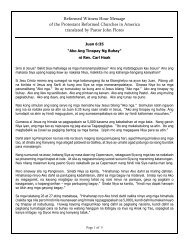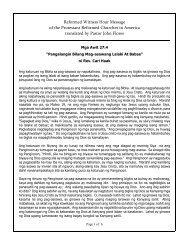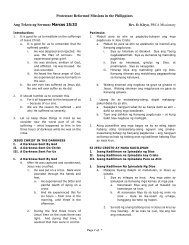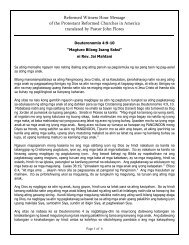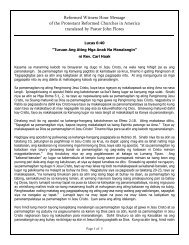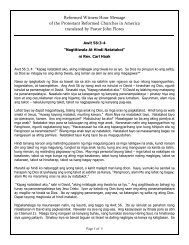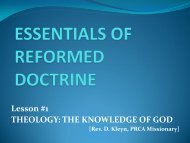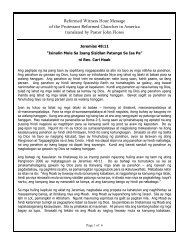You also want an ePaper? Increase the reach of your titles
YUMPU automatically turns print PDFs into web optimized ePapers that Google loves.
Stabilizing Wage PolicybyMordecai Kurz,Department of Economics Stanford University, Stanford, CA.(This version: May 27, 2015)Summary: A rapid recovery from deflationary shocks that result in transition to the Zero Lower Bound (ZLB) requires that policygenerate an inflationary counter-force. Monetary policy cannot achieve it and the lesson of the 2007-2015 Great Recession is that growingdebt give rise to a political gridlock which prevents restoration to full employment with deficit financed public spending. Even optimalinvestments in needed public projects cannot be undertaken at a zero interest rate. Hence, failure of policy to arrest the massive damage ofeight year’s Great Recession shows the need for new policy tools. I propose such policy under the ZLB called “Stabilizing Wage Policy”which requires public intervention in markets instead of deficit financed expenditures. Section 1 develops a New Keynesian model withdiverse beliefs and inflexible wages. Section 2 presents the policy and studies its efficacy.The integrated New Keynesian (NK) model economy consists of a lower sub-economy under a ZLB and upper sub-economywith positive rate, linked by random transition between them. Household-firm-managers hold heterogenous beliefs and inflexible wage isbased on a four quarter staggered wage structure so that mean wage is a relatively inflexible function of inflation, of unemployment and ofa distributed lag of productivity. Equilibrium maps of the two sub-economies exhibit significant differences which emerge from therelative rates at which the nominal rate, prices and wage rate adjust to shocks. Two key results: first, decline to the ZLB lower subeconomycauses a powerful debt-deflation spiral. Second, output level, inflation and real wages rise in the lower sub-economy if all basewages are unexpectedly raised. Unemployment falls. This result is explored and explained since it is the key analytic result that motivatesthe policy.A Stabilizing Wage Policy aims to repair households’ balance sheets, expedite recovery and exit from the ZLB. It raises basewages for policy duration with quarterly cost of living adjustment and a prohibition to alter base wages in order to nullify the policy. I usedemand shocks to cause recession under a ZLB and a deleveraging rule to measure recovery. The rule is calibrated to repair damagedbalance sheets of US households in 2007-2015. Sufficient deleveraging and a positive rate in the upper sub-economy without a wage policyare required for exit hence at exit time inflation and output in the lower sub-economy are irrelevant for exit decision. Simulations showeffective policy selects high policy intensity at the outset and given the 2007-2015 experience, a constant 10% increased base wages raisesequilibrium mean wage by about 5.5%, generates a controlled inflation of 5%-6% at exit time and attains recovery in a fraction of the timeit takes for recovery without policy. Under a successful policy inflation exceeds the target at exit time and when policy terminates,inflation abates rapidly if the inflation target is intact. I suggest that a stabilizing wage policy with a constant 10% increased base wagescould have been initiated in September 2008. If controlled inflation of 5% for 2.25 years would have been politically tolerated, the USwould have recovered and exited the ZLB in 9 quarters and full employment restored by 2012. Lower policy intensity would have resultedin smaller increased mean wage, lower inflation but increased recession’s duration. The policy would not have required any federal budgetexpenditures, it would have reduced public deficits after 2010 and the US would have reached 2015 with a lower national debt.The policy negates the effect of demand shocks which cause the recession and the binding ZLB. It attains it’s goal with strongtemporary intervention in the market instead of generating demand with public expenditures. It does not solve other long term structuralproblems that persist after exit from the ZLB and which require other solutions.JEL classification: D21, E12, E24, E3, E4, E52, E6, H3, J3, J6.Keywords: New Keynesian Model; wage scale; reference wage; inflexible wages; sticky prices;heterogenous beliefs; market belief; Rational Beliefs; Great Recession; Depression; monetary policy;Stabilizing Wage Policy.For Correspondence:Professor Mordecai KurzDepartment of Economics, Landau BuildingStanford UniversityStanford, CA. 94305 - 6072Email: mordecai@stanford.edu



